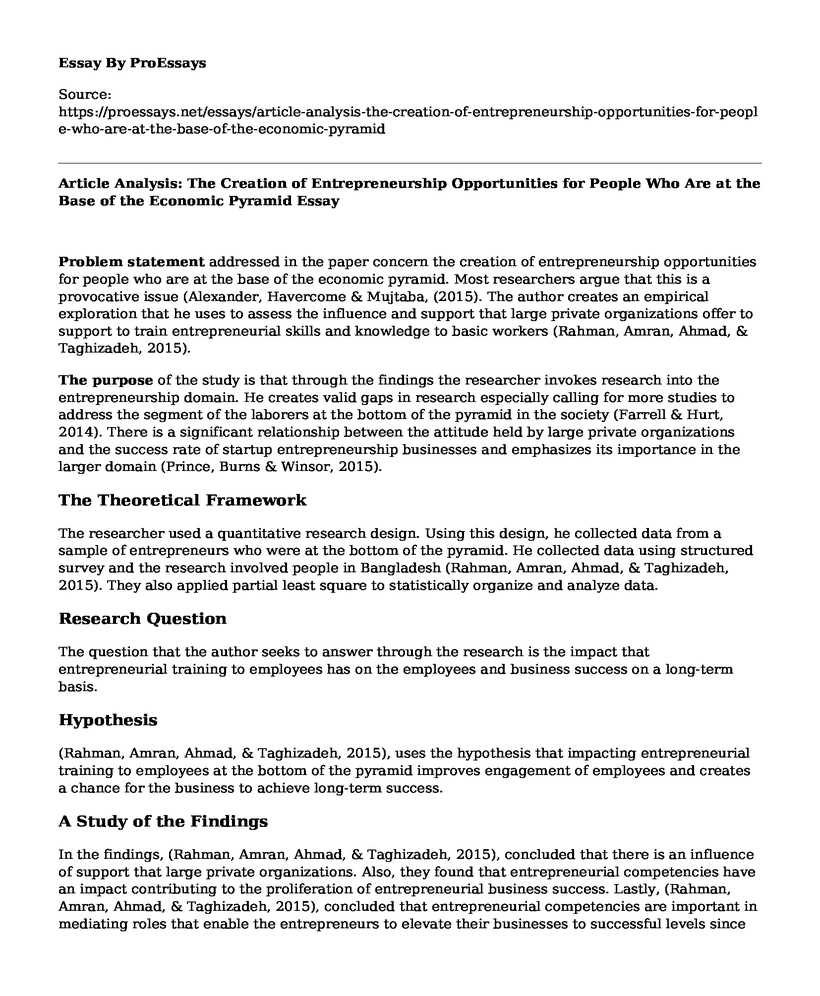Problem statement addressed in the paper concern the creation of entrepreneurship opportunities for people who are at the base of the economic pyramid. Most researchers argue that this is a provocative issue (Alexander, Havercome & Mujtaba, (2015). The author creates an empirical exploration that he uses to assess the influence and support that large private organizations offer to support to train entrepreneurial skills and knowledge to basic workers (Rahman, Amran, Ahmad, & Taghizadeh, 2015).
The purpose of the study is that through the findings the researcher invokes research into the entrepreneurship domain. He creates valid gaps in research especially calling for more studies to address the segment of the laborers at the bottom of the pyramid in the society (Farrell & Hurt, 2014). There is a significant relationship between the attitude held by large private organizations and the success rate of startup entrepreneurship businesses and emphasizes its importance in the larger domain (Prince, Burns & Winsor, 2015).
The Theoretical Framework
The researcher used a quantitative research design. Using this design, he collected data from a sample of entrepreneurs who were at the bottom of the pyramid. He collected data using structured survey and the research involved people in Bangladesh (Rahman, Amran, Ahmad, & Taghizadeh, 2015). They also applied partial least square to statistically organize and analyze data.
Research Question
The question that the author seeks to answer through the research is the impact that entrepreneurial training to employees has on the employees and business success on a long-term basis.
Hypothesis
(Rahman, Amran, Ahmad, & Taghizadeh, 2015), uses the hypothesis that impacting entrepreneurial training to employees at the bottom of the pyramid improves engagement of employees and creates a chance for the business to achieve long-term success.
A Study of the Findings
In the findings, (Rahman, Amran, Ahmad, & Taghizadeh, 2015), concluded that there is an influence of support that large private organizations. Also, they found that entrepreneurial competencies have an impact contributing to the proliferation of entrepreneurial business success. Lastly, (Rahman, Amran, Ahmad, & Taghizadeh, 2015), concluded that entrepreneurial competencies are important in mediating roles that enable the entrepreneurs to elevate their businesses to successful levels since the entrepreneurs have the necessary training skills and technical support required.
From the findings, (Rahman, Amran, Ahmad, & Taghizadeh, 2015), proposed that the practical implication would be to have business organizations embrace the entrepreneurial business training for use as a business model and as a method of contributing to social welfare initiatives.
(Farrell & Hurt, 2014) argues that training employees are critical because it presents attractive opportunism to enable the rapid growth of the organization. The author presents those employees at the bottom of the pyramid as people with potential and seeking opportunities to grow and add value to themselves (Anitha, 2014). Having a pool of human resources will ensure that there is a variety of proposal in the management and decision making of the organization. (Farrell & Hurt, 2014) agrees that the diversity in approaches and strategy will give the organization a competitive advantage.
Analysis of the Alignment and Misalignment
Most major elements of the research are logically and to some extent methodologically aligned with other elements. The questions for the research align with the hypothesis which in turn is aligned with the conceptual model. These elements are well aligned with each other. However, the research methodology does not appear to align well with other elements.
Recommended Change to Improve Alignment Within This Study
The study design that would fit the study best is a phenomenological design because it can be used to determine participants perceive the entrepreneurship business training at a personal level.
References
Alexander, V., Havercome, C., & Mujtaba, B. G. (2015). Effectively Managing Employees to Get Results in a Diverse Workplace such as American Express. Journal Of Business Studies Quarterly,, 7(1).
Anitha, J. (2014). Determinants of employee engagement and their impact on employee perfor-mance. International. Journal Of Productivity And Performance Management.
Arseneau, J. R., Asay, P. A., Paquin, J. D., Walton, H. M., Downing, V., Roffman, M. S., & Fassinger, R. E. (2017). Career Success of Women in the Chemical Industry, Part 2: Navigating Workplace Challenges. In Diversity in the Scientific Community Volume 1. (2017). Quantifying Diversity And Formulating Success (Pp. 145-172). American Chemical Society., 2.
Farrell, L., & Hurt, A. C. (2014). Training the Millennial Generation: Implications for Organizational Climate. (2014). E Journal Of Organizational Learning & Leadership,, 12(1).
Prince, M., Burns, D., Lu, X., & Winsor, R. (2015). Knowledge and skills transfer between MBA and workplace. (2015). Journal Of Workplace Learning,, 27(3).
Rahman, S. A., Amran, A., Ahmad, N. H., & Taghizadeh, S. K. (2015). Supporting entrepreneurial business success at the base of pyramid through entrepreneurial competencies. Management Decision, 53(6), 1203-1223. doi:10.1108/md-08-2014-0531
Cite this page
Article Analysis: The Creation of Entrepreneurship Opportunities for People Who Are at the Base of the Economic Pyramid. (2021, Sep 02). Retrieved from https://proessays.net/essays/article-analysis-the-creation-of-entrepreneurship-opportunities-for-people-who-are-at-the-base-of-the-economic-pyramid
If you are the original author of this essay and no longer wish to have it published on the ProEssays website, please click below to request its removal:
- Effects of Globalization and Neoliberalism on States
- Identifying the Cultural Characteristics of My Family
- Operation in the Global Market Essay
- Albin Polasek Museum and Sculpture Gardens in Winter Park Essay
- Employers Must Provide Acceptable Health Insurance Coverage to Avoid Fines - Essay Sample
- Essay on UPS India: Establishing Its Global Network in Fast-Growing Markets
- Essay Example on Women On Top: Managerial Strategies in Entrepreneur Sectors







